
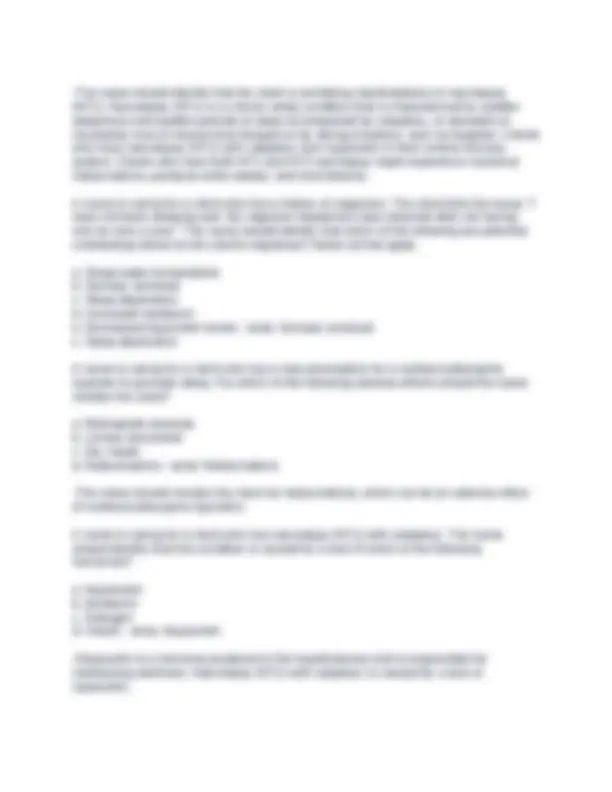
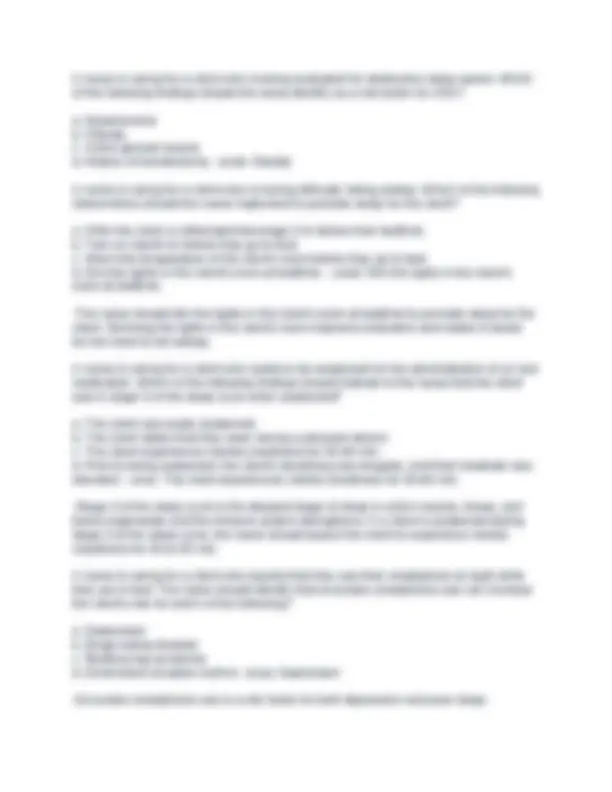
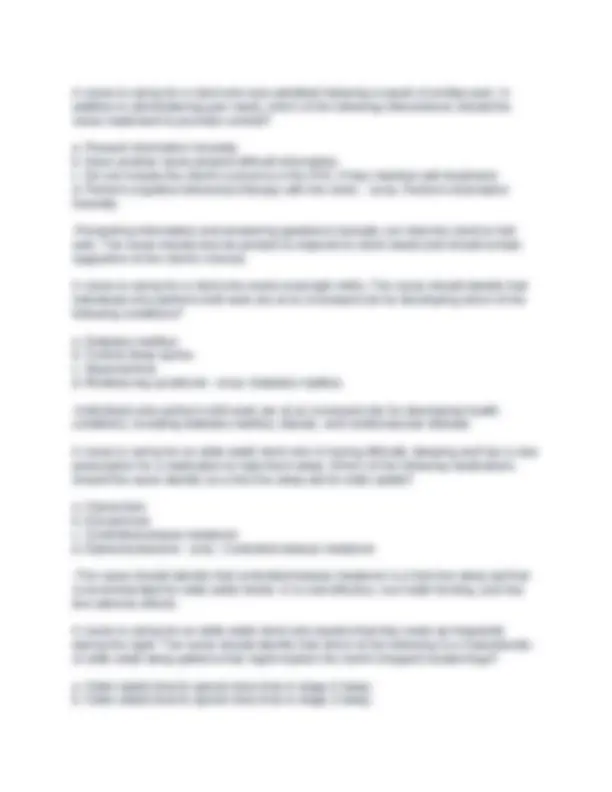
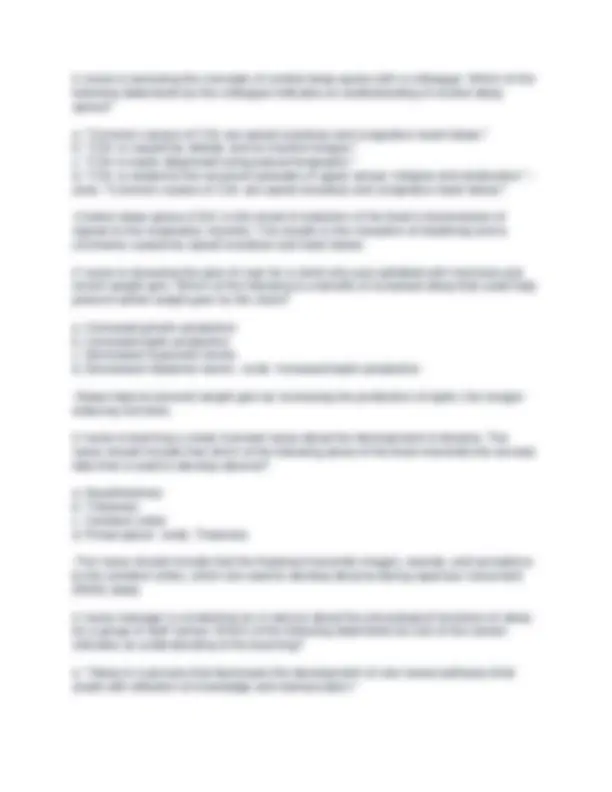
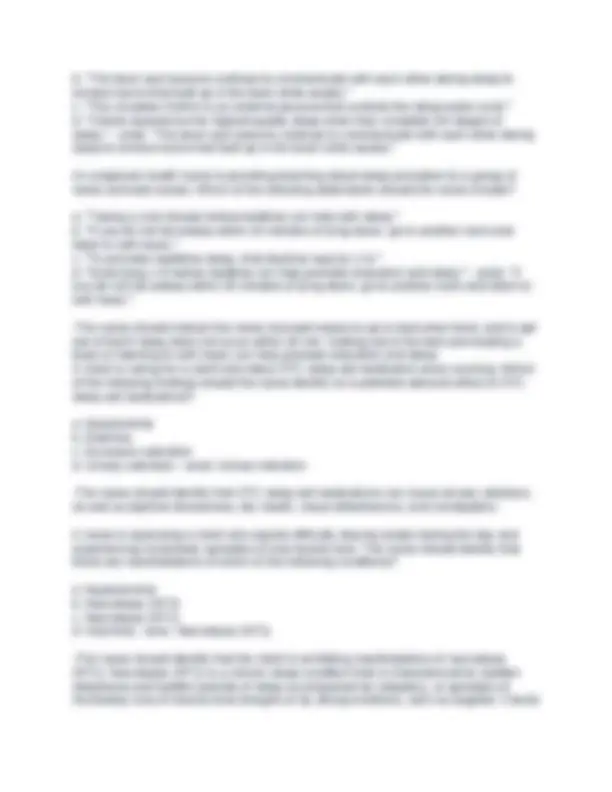
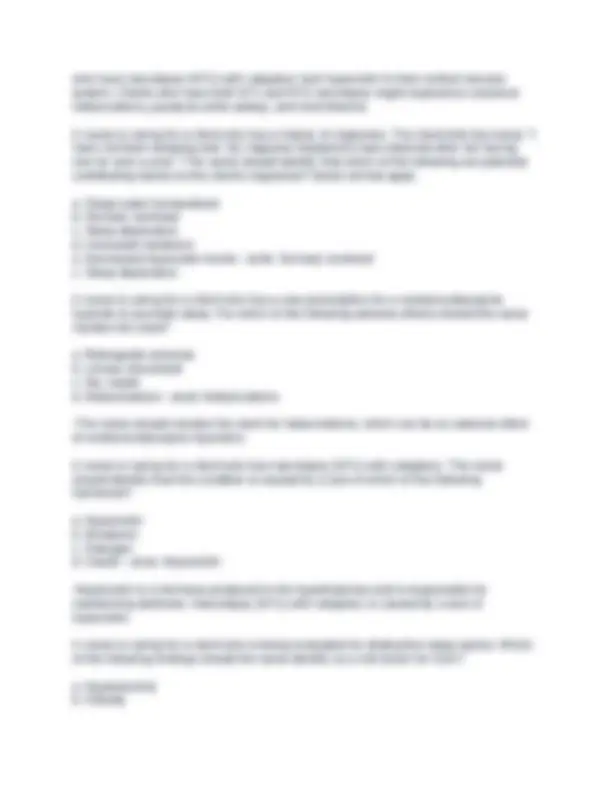

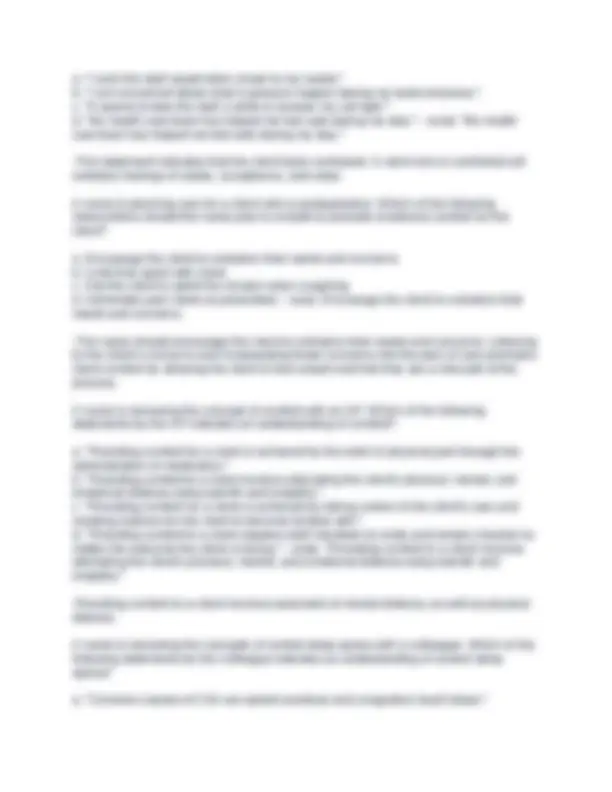
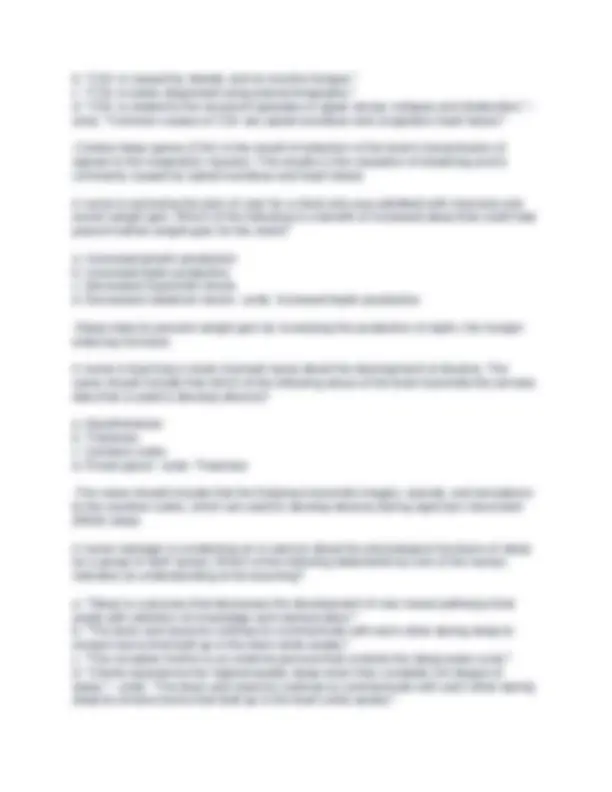


Study with the several resources on Docsity

Earn points by helping other students or get them with a premium plan


Prepare for your exams
Study with the several resources on Docsity

Earn points to download
Earn points by helping other students or get them with a premium plan
Community
Ask the community for help and clear up your study doubts
Discover the best universities in your country according to Docsity users
Free resources
Download our free guides on studying techniques, anxiety management strategies, and thesis advice from Docsity tutors
A series of multiple-choice questions and answers related to comfort, rest, and sleep in nursing practice. It covers topics such as evidence-based practice, quality improvement, incident reporting, sleep disorders, and interventions to promote sleep. The questions are designed to assess understanding of key concepts and clinical applications in the field of nursing.
Typology: Exams
1 / 16

This page cannot be seen from the preview
Don't miss anything!










A nurse is a member of a committee that is using evidence-based practice (EBP) to decrease the incidence of central line infections. The nurse should identify that which of the following interventions is part of the implementation step of EBP? - ansIncorporating the new practice into client care A nurse is assisting a quality improvement team that is using the Plan-Do-Study-Act (PDSA) model to address an increase in pressure injuries on a medical unit. Which of the following actions should the nurse identify as an example of the "Do" step of the PDSA model? - ansImplementing a new evidence-based practice protocol A nurse is assisting on a quality improvement committee to decrease the number of client falls occurring at night. After identifying the problem, which of the following is the next step the nurse should take? - ansComplete a literature review. A nurse is assisting with developing a quality improvement (QI) plan to reduce the incidence of medication errors in an acute care unit. The nurse should recognize that which of the following actions is included in the identifying step of the QI process? - ansRecognizing a need for a change A nurse is assisting with teaching a class about incident reports. The nurse should include that which of the following situations requires an incident report? - ansA nurse administers the wrong medication to a client. A nurse is assisting with teaching a class about quality core measures. Which of the following information should the nurse include? - ansQuality core measures are a standard of care for treatment. A nurse is assisting with teaching a class about sentinel events. The nurse should include that which of the following situations is a sentinel event? - ansA nurse infused an incompatible blood product to a client. A nurse is assisting with teaching a class about types of research studies. The nurse should include that which of the following is an example of a randomized controlled trial (RCT)? - ansA study arbitrarily assigning people who smoke into either an experimental group or a control group to determine the effects of a new therapy to reduce smoking A nurse is assisting with teaching a newly licensed nurse about the Hospital Consumer Assessment of Healthcare Providers and Systems (HCAHPS) tool. Which of the following information should the nurse include? - ansThe HCAHPS tool is issued to measure client satisfaction about health care service.
A nurse is assisting with using the Plan-Do-Study-Act (PDSA) model to decrease client falls in a long-term care facility. The nurse should identify that developing guidelines to decrease falls is included in which of the following steps of the PDSA model? - ansPlan A nurse is caring for a client who has suction equipment in their room. The client asks the nurse, "Why do you check my suction equipment every day even though I am not using it?" Which of the following statements should the nurse make? - ans"It is part of the quality assurance plan of the unit." A nurse is discussing quality measurement with a newly licensed nurse. The nurse should include that medication reconciliation is an aspect of which of the following parts of quality measurement? - ansProcess A nurse is explaining National Patient Safety Goals (NPSGs) to a newly licensed nurse. The nurse should include that which of the following is a goal addressed in the NPSGs?
A nurse is caring for a client who is being evaluated for obstructive sleep apnea. Which of the following findings should the nurse identify as a risk factor for OSA? a. Hypersomnia b. Obesity c. Active glossal muscle d. History of tonsillectomy - ansb. Obesity A nurse is caring for a client who is having difficulty falling asleep. Which of the following interventions should the nurse implement to promote sleep for the client? a. Offer the client a caffeinated beverage 3 hr before their bedtime. b. Turn on client's tv before they go to bed. c. Warm the temperature of the client's room before they go to bed. d. Dim the lights in the client's room at bedtime. - ansd. Dim the lights in the client's room at bedtime. -The nurse should dim the lights in the client's room at bedtime to promote sleep for the client. Dimming the lights in the client's room improves relaxation and makes it easier for the client to fall asleep. A nurse is caring for a client who needs to be awakened for the administration of an oral medication. Which of the following findings should indicate to the nurse that the client was in stage 3 of the sleep cycle when awakened? a. The client was easily awakened. b. The client states that they were having a pleasant dream. c. The client experiences mental cloudiness for 30-60 min. d. Prior to being awakened, the client's breathing was irregular, and their heartrate was elevated. - ansc. The client experiences mental cloudiness for 30-60 min. -Stage 3 of the sleep cycle is the deepest stage of sleep in which muscle, tissue, and bones regenerate and the immune system strengthens. If a client is awakened during stage 3 of the sleep cycle, the nurse should expect the client to experience mental cloudiness for 30 to 60 min. A nurse is caring for a client who reports that they use their smartphone at night while they are in bed. The nurse should identify that excessive smartphone use can increase the client's risk for which of the following? a. Depression b. Binge eating disorder c. Restless leg syndrome d. Diminished circadian rhythm - ansa. Depression -Excessive smartphone use is a risk factor for both depression and poor sleep.
A nurse is caring for a client who was admitted following a report of lumbar pain. In addition to administering pain meds, which of the following interventions should the nurse implement to promote comfort? a. Present information honestly. b. Have another nurse present difficult information. c. Do not include the client's concerns in the POC if they interfere with treatment. d. Perform cognitive behavioral therapy with the client. - ansa. Perform information honestly. -Presenting information and answering questions honestly can help the client to feel safe. The nurse should also be present to respond to client needs and should remain supportive of the client's choices. A nurse is caring for a client who works overnight shifts. The nurse should identify that individuals who perform shift work are at an increased risk for developing which of the following conditions? a. Diabetes mellitus b. Central sleep apnea c. Hypersomnia d. Restless leg syndrome - ansa. Diabetes mellitus -Individuals who perform shift work are at an increased risk for developing health conditions, including diabetes mellitus, obesity, and cardiovascular disease. A nurse is caring for an older adult client who is having difficulty sleeping and has a new prescription for a medication to help them sleep. Which of the following medications should the nurse identify as a first line sleep aid for older adults? a. Alprazolam b. Eszopiclone c. Controlled-release melatonin d. Diphenhydramine - ansc. Controlled-release melatonin -The nurse should identify that controlled-release melatonin is a first-line sleep aid that is recommended for older adult clients. It is cost-effective, non-habit forming, and has few adverse effects. A nurse is caring for an older adult client who reports that they wake up frequently during the night. The nurse should identify that which of the following is a characteristic of older adult sleep patterns that might explain the client's frequent awakenings? a. Older adults tend to spend more time in stage 4 sleep. b. Older adults tend to spend more time in stage 3 sleep.
A nurse is evaluating a client after measures to promote comfort have been implemented. Which of the following statements by the client indicates that the client has been comforted? a. "I wish the staff would listen closer to my needs." b. "I am concerned about what is going to happen during my tests tomorrow." c. "It seems to take the staff a while to answer my call light." d. "My health care team has helped me feel safe during my stay." - ansd. "My health care team has helped me feel safe during my stay." -This statement indicates that the client feels comforted. A client who is comforted will verbalize feelings of safety, acceptance, and value. A nurse is planning care for a client who is postoperative. Which of the following interventions should the nurse plan to include to promote emotional comfort for the client? a. Encourage the client to verbalize their needs and concerns. b. Limit time spent with client. c. Ask the client to splint the incision when coughing. d. Administer pain meds as prescribed. - ansa. Encourage the client to verbalize their needs and concerns. -The nurse should encourage the client to verbalize their needs and concerns. Listening to the client's concerns and incorporating those concerns into the plan of care promotes client comfort by allowing the client to feel valued and that they are a vital part of the process. A nurse is reviewing the concept of comfort with an AP. Which of the following statements by the AP indicates an understanding of comfort? a. "Providing comfort for a client is achieved by the relief of physical pain through the administration of medication." b. "Providing comfort to a client involves alleviating the client's physical, mental, and emotional distress using warmth and empathy." c. "Providing comfort for a client is achieved by taking control of the client's care and creating routines for the client to become familiar with." d. "Providing comfort to a client requires staff members to smile and remain cheerful no matter the outcome the client is facing." - ansb. "Providing comfort to a client involves alleviating the client's physical, mental, and emotional distress using warmth and empathy." -Providing comfort to a client involves easement of mental distress, as well as physical distress.
A nurse is reviewing the concepts of central sleep apnea with a colleague. Which of the following statements by the colleague indicates an understanding of central sleep apnea? a. "Common causes of CSA are opioid overdose and congestive heart failure." b. "CSA is caused by obesity and an inactive tongue." c. "CSA is easily diagnosed using polysomnography." d. "CSA is related to the recurrent episodes of upper airway collapse and obstruction." - ansa. "Common causes of CSA are opioid overdose and congestive heart failure." -Central sleep apnea (CSA) is the result of reduction of the brain's transmission of signals to the respiratory muscles. This results in the cessation of breathing and is commonly caused by opioid overdose and heart failure. A nurse is reviewing the plan of care for a client who was admitted with insomnia and recent weight gain. Which of the following is a benefit of increased sleep that could help prevent further weight gain for the client? a. Increased ghrelin production b. Increased leptin production c. Decreased hypocretin levels d. Decreased melatonin levels - ansb. Increased leptin production -Sleep helps to prevent weight gain by increasing the production of leptin, the hunger- reducing hormone. A nurse is teaching a newly licensed nurse about the development of dreams. The nurse should include that which of the following areas of the brain transmits the sensory data that is used to develop dreams? a. Hypothalamus b. Thalamus c. Cerebral cortex d. Pineal gland - ansb. Thalamus -The nurse should include that the thalamus transmits images, sounds, and sensations to the cerebral cortex, which are used to develop dreams during rapid eye movement (REM) sleep. A nurse manager is conducting an in-service about the physiological functions of sleep for a group of staff nurses. Which of the following statements by one of the nurses indicates an understanding of the teaching? a. "Sleep is a process that decreases the development of new neural pathways that assist with retention of knowledge and memorization."
who have narcolepsy (NT1) with cataplexy lack hypocretin in their central nervous system. Clients who have both NT1 and NT2 narcolepsy might experience nocturnal hallucinations, paralysis while asleep, and vivid dreams. A nurse is caring for a client who has a history of migraines. The client tells the nurse, "I have not been sleeping well. My migraine headaches have returned after not having one for over a year." The nurse should identify that which of the following are potential contributing factors to the client's migraines? Select all that apply. a. Sleep-wake homeostasis b. Sensory overload c. Sleep deprivation d. Increased melatonin e. Decreased hypocretin levels - ansb. Sensory overload c. Sleep deprivation A nurse is caring for a client who has a new prescription for a nonbenzodiazepine hypnotic to promote sleep. For which of the following adverse effects should the nurse monitor the client? a. Retrograde amnesia b. Urinary discomfort c. Dry mouth d. Hallucinations - ansd. Hallucinations -The nurse should monitor the client for hallucinations, which can be an adverse effect of nonbenzodiazepine hypnotics. A nurse is caring for a client who has narcolepsy (NT1) with cataplexy. The nurse should identify that this condition is caused by a lack of which of the following hormones? a. Hypocretin b. Melatonin c. Estrogen d. Insulin - ansa. Hypocretin -Hypocretin is a hormone produced in the hypothalamus and is responsible for maintaining alertness. Narcolepsy (NT1) with cataplexy is caused by a lack of hypocretin. A nurse is caring for a client who is being evaluated for obstructive sleep apnea. Which of the following findings should the nurse identify as a risk factor for OSA? a. Hypersomnia b. Obesity
c. Active glossal muscle d. History of tonsillectomy - ansb. Obesity A nurse is caring for a client who is having difficulty falling asleep. Which of the following interventions should the nurse implement to promote sleep for the client? a. Offer the client a caffeinated beverage 3 hr before their bedtime. b. Turn on client's tv before they go to bed. c. Warm the temperature of the client's room before they go to bed. d. Dim the lights in the client's room at bedtime. - ansd. Dim the lights in the client's room at bedtime. -The nurse should dim the lights in the client's room at bedtime to promote sleep for the client. Dimming the lights in the client's room improves relaxation and makes it easier for the client to fall asleep. A nurse is caring for a client who needs to be awakened for the administration of an oral medication. Which of the following findings should indicate to the nurse that the client was in stage 3 of the sleep cycle when awakened? a. The client was easily awakened. b. The client states that they were having a pleasant dream. c. The client experiences mental cloudiness for 30-60 min. d. Prior to being awakened, the client's breathing was irregular, and their heartrate was elevated. - ansc. The client experiences mental cloudiness for 30-60 min. -Stage 3 of the sleep cycle is the deepest stage of sleep in which muscle, tissue, and bones regenerate and the immune system strengthens. If a client is awakened during stage 3 of the sleep cycle, the nurse should expect the client to experience mental cloudiness for 30 to 60 min. A nurse is caring for a client who reports that they use their smartphone at night while they are in bed. The nurse should identify that excessive smartphone use can increase the client's risk for which of the following? a. Depression b. Binge eating disorder c. Restless leg syndrome d. Diminished circadian rhythm - ansa. Depression -Excessive smartphone use is a risk factor for both depression and poor sleep. A nurse is caring for a client who was admitted following a report of lumbar pain. In addition to administering pain meds, which of the following interventions should the nurse implement to promote comfort?
-Older adults tend to spend more time in stage 2 sleep compared to adults. Stage 2 is a lighter stage of sleep than stages 3 and 4. This can contribute to the client's frequent awakenings because environmental factors, such as noise, are more likely to rouse someone who is in stage 2 sleep. A nurse is contributing to a presentation about hypersomnia. Which of the following information should the nurse recommend including in the presentation? a. Hypersomnia does not improve with increased sleep. b. Hypersomnia is associated with a disturbed circadian rhythm. c. Clients who experience hypersomnia have a longer attention span. d. Clients who experience hypersomnia lack the hormone hypocretin. - ansa. Hypersomnia does not improve with increased sleep. -The nurse should recommend including that hypersomnia is characterized by excessive daytime fatigue that does not improve if the client receives additional sleep. A nurse is contributing to a presentation about nonpharmacological interventions used to promote sleep. Which of the following information should the nurse recommend including in the presentation? a. Nonpharmacological interventions should only be practiced in the client's home setting. b. Massage is a NI that should be used to promote sleeping for clients who are taking anticoagulants. c. NI used to help promote sleep include acupuncture and thermotherapy. d. Before implementing NI, clients should be evaluated by a sleep specialist for sleep apnea and chronic lung disease. - ansc. NI used to help promote sleep include acupuncture and thermotherapy. A nurse is discussing the stages of the sleep cycle with a client. The nurse should include that the immune system is strengthened, and tissues and bones are repaired during which of the following stages of the sleep cycle? a. Stage 1 b. Stage 2 c. Stage 3 d. Stage 4 - ansc. Stage 3 -The nurse should include that the immune system is strengthened and tissues and bones are repaired during stage 3 of the sleep cycle. A nurse is evaluating a client after measures to promote comfort have been implemented. Which of the following statements by the client indicates that the client has been comforted?
a. "I wish the staff would listen closer to my needs." b. "I am concerned about what is going to happen during my tests tomorrow." c. "It seems to take the staff a while to answer my call light." d. "My health care team has helped me feel safe during my stay." - ansd. "My health care team has helped me feel safe during my stay." -This statement indicates that the client feels comforted. A client who is comforted will verbalize feelings of safety, acceptance, and value. A nurse is planning care for a client who is postoperative. Which of the following interventions should the nurse plan to include to promote emotional comfort for the client? a. Encourage the client to verbalize their needs and concerns. b. Limit time spent with client. c. Ask the client to splint the incision when coughing. d. Administer pain meds as prescribed. - ansa. Encourage the client to verbalize their needs and concerns. -The nurse should encourage the client to verbalize their needs and concerns. Listening to the client's concerns and incorporating those concerns into the plan of care promotes client comfort by allowing the client to feel valued and that they are a vital part of the process. A nurse is reviewing the concept of comfort with an AP. Which of the following statements by the AP indicates an understanding of comfort? a. "Providing comfort for a client is achieved by the relief of physical pain through the administration of medication." b. "Providing comfort to a client involves alleviating the client's physical, mental, and emotional distress using warmth and empathy." c. "Providing comfort for a client is achieved by taking control of the client's care and creating routines for the client to become familiar with." d. "Providing comfort to a client requires staff members to smile and remain cheerful no matter the outcome the client is facing." - ansb. "Providing comfort to a client involves alleviating the client's physical, mental, and emotional distress using warmth and empathy." -Providing comfort to a client involves easement of mental distress, as well as physical distress. A nurse is reviewing the concepts of central sleep apnea with a colleague. Which of the following statements by the colleague indicates an understanding of central sleep apnea? a. "Common causes of CSA are opioid overdose and congestive heart failure."
An employee health nurse is providing teaching about sleep promotion to a group of newly licensed nurses. Which of the following statements should the nurse include? a. "Taking a cool shower before bedtime can help with sleep." b. "If you do not fall asleep within 20 minutes of lying down, go to another room and listen to soft music." c. "To promote nighttime sleep, limit daytime naps to 1 hr." d. "Exercising 1 hr before bedtime can help promote relaxation and sleep." - ansb. "If you do not fall asleep within 20 minutes of lying down, go to another room and listen to soft music." -The nurse should instruct the newly licensed nurses to go to bed when tired, and to get out of bed if sleep does not occur within 20 min. Getting out of the bed and reading a book or listening to soft music can help promote relaxation and sleep.